Baltit Fort
Located in central Hunza, the Baltit Fort Karimabad is one of the “Best Tourist Sites” in Pakistan. It has stood firmly and gracefully for over 700 years in the face of many battles, enemy attacks, and natural calamities like earthquakes. Perched high upon a mountain, overlooking the great Karakoram highway and turquoise Hunza Valley, Baltit Fort is no less than a paradise for its visitors. Standing amongst some of the highest mountains of the Gilgit Baltistan region, this prehistoric masterpiece provides a great insight into the history of Hunza and the lives of the Hunza people. Rulers of Hunza, also called Mirs of Hunza, lived in Baltit Fort Karimabad centuries ago. It is a symbolic representation of the chivalry and bravery of the Hunza people. Considered one of the most astonishing architectural masterpieces of Hunza district, Baltit Fort, located in the heart of Gilgit Baltistan, is a popular tourist attraction visited by tourists from across the globe. When you visit Baltit Fort, you will come across many tourists there. Let us dive into the history and many attractions this spectacular site offers. It is one of the most popular forts in Pakistan.
The Architecture of Baltit Fort
The architects built the fortress’s structure using wood and stone to stabilize its ancient foundation. Red bricks on the exterior of the building represent Tibetan architecture. The building is painted white with colored glass windows. The stone-made walls have additional timber scaffolding. A timber and stone tower is constructed for defense and protection and to keep an eye on the entire region. Below the Ultar glacier, this historical monument stands on a flattened spur, snuggled between the highest mountains of Gilgit Baltistan. Baltit Fort consists of three floors with a rectangular plain. Rulers modified it many times but didn’t build it entirely. The design of the majority of fortifications located in Hunza reflects Tibetan architectural design. Baltit Fort resembles Tibetan architecture in terms of color and design because Baltistan was once a part of Tibet, just like Ladakh. The architectural design of Baltit Fort resembles a lot of the structure of the Potala palace in Lhasa. It is also built at a great height, just like the Baltit Fort, to make it difficult for the enemies to invade and attack.
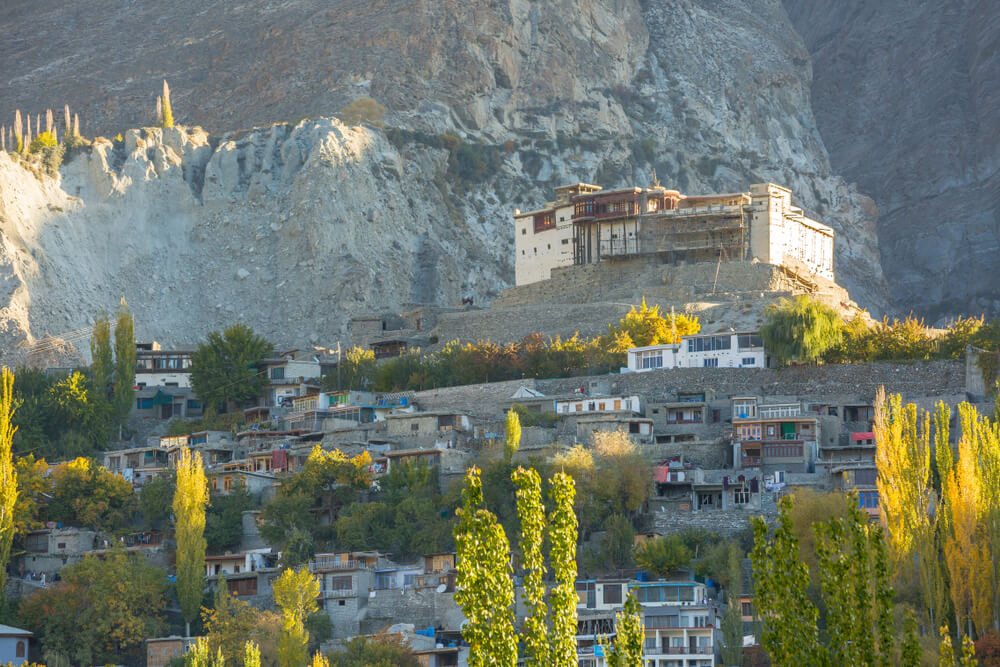
The most well-known town in Hunza, Karimabad, has a steep street that leads to the Hunza Baltit Fort which was once the capital of the Hunza district. Karimabad locates in a broad valley with lush green fields. The Ultar irrigation system irrigates this valley.
History of Baltit Fort
The Baltit Fort has a long history that dates back to the fifteenth century, when Tham/Mir (ruler) of Hunza, Ayasho II, married princess shah Khatoon, the daughter of Raja Abdal, the ruler of Baltistan. According to historical facts and inhabitants of Hunza, King Raja Abdal, after marrying his daughter, sent a team of skilled Tibetan artisans from his kingdom to the Hunza district as a dowry. Those Tibetan artisans constructed and modified the Baltit Fort so the king’s daughter could live a peaceful and magnificent life.
In ancient times, several independent states were living in Gilgit Baltistan. Among them, there were two opponent states, Hunza and Nagar. Rulers of that time (known as Tham) followed a tradition of building forts to showcase their superiority and power to their rival states. According to historical facts, a family conflict emerged between two royal brothers, prince Shah Abbas (Shabbos) and prince Ali khan, in the late 1540s. Elder brother Shabbos made Baltit Fort his stronghold while younger brother Ali khan held Altit fort under his command. Ali khan was entombed alive by his elder brother in the Altit fort for the kingdom’s sake. Later on, shabbos declared Baltit Fort the capital of Hunza.
Attractions at Baltit Fort
The Baltit Fort Karimabad is a symbol of power in the Hunza district. Let us dive into the attractions offered by this masterpiece.
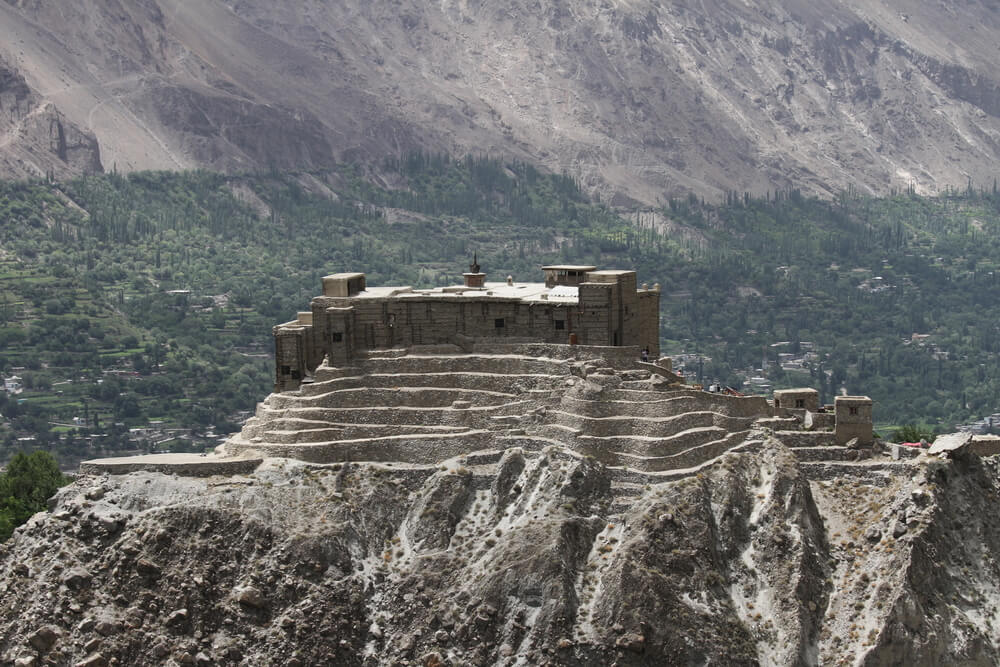
Wood-and-stone structure with mud plaster
The significant elements used in the construction of Baltit Fort Hunza are stones and strong wood. Usage of mud plaster all over the Fort strengthened this wood and stone structure. The whole building is built on the concept of timber framing so that the Fort’s walls can withstand the vital forces of an earthquake.
Man-Made narrow terraces
The rulers of Hunza inhabited both Baltit and Altit fort. The last ruler of Hunza, Mir Muhammad Jamal khan, left the Baltit Fort and shifted into a new modern palace in the villages. As a result, the Baltit Fort remained neglected and abandoned from 1945 to 1990. Consequently, the Hunza Baltit Fort became worn to the point that it was about to collapse. In 1979, Richard Hughes, an engineer, visited the Fort and realized the severity of the situation. He convinced the rulers of the state to renovate the Fort. They reconstructed many things, including narrow terraces, to add beauty to the structure of the Fort.
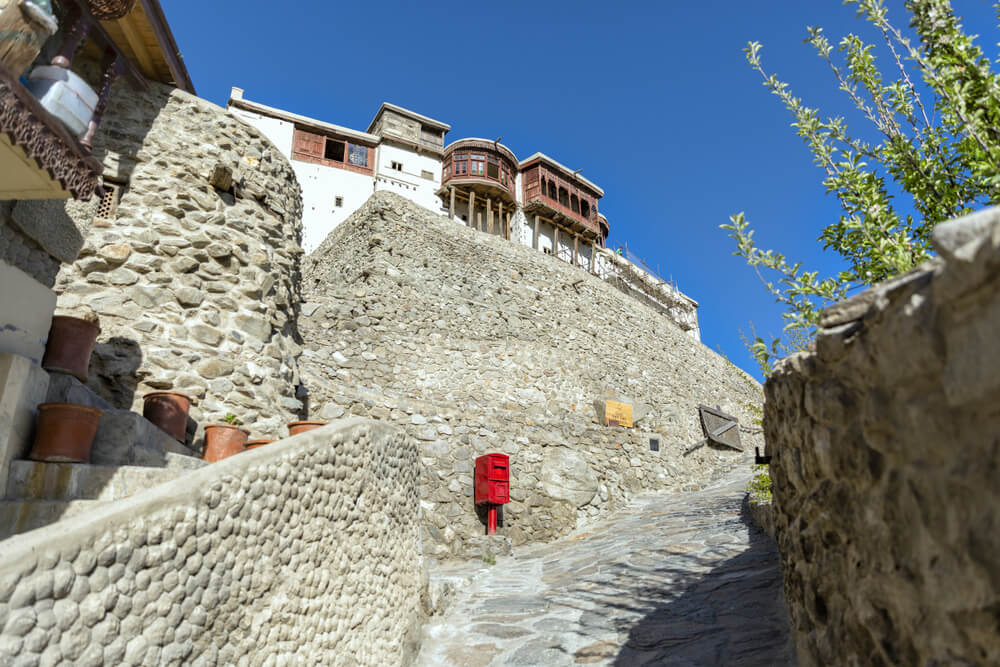
The terraces’ walls have rectangular stones with rounded edges that fit like puzzle blocks. The tourists can enjoy the beautiful view outside the Fort from these narrow terraces.
An ancient collection of swords and weapons at Baltit Fort
The rulers of Hunza were fond of importing artifacts from China and Russia. They used to buy weapons and ornaments from these countries. Skilled swordsmiths of that time adorned the walls of the Baltit Fort with an ancient collection of imported swords, spears, and a bow.
Open terrace with a royal throne
In December 1891, the British authorities ordered the demolition of the fortified walls and watched the towers of the old Baltit Fort. In September 1892, the British handed over the possession of Hunza state to Mir Muhammad Nazim Khan. He modified the Baltit Fort Karimabad in every way possible during his governance. He removed the old-fashioned rooms and constructed new rooms of modern style on the third floor. The addition of colored glass panel windows increases the rooms’ beauty.
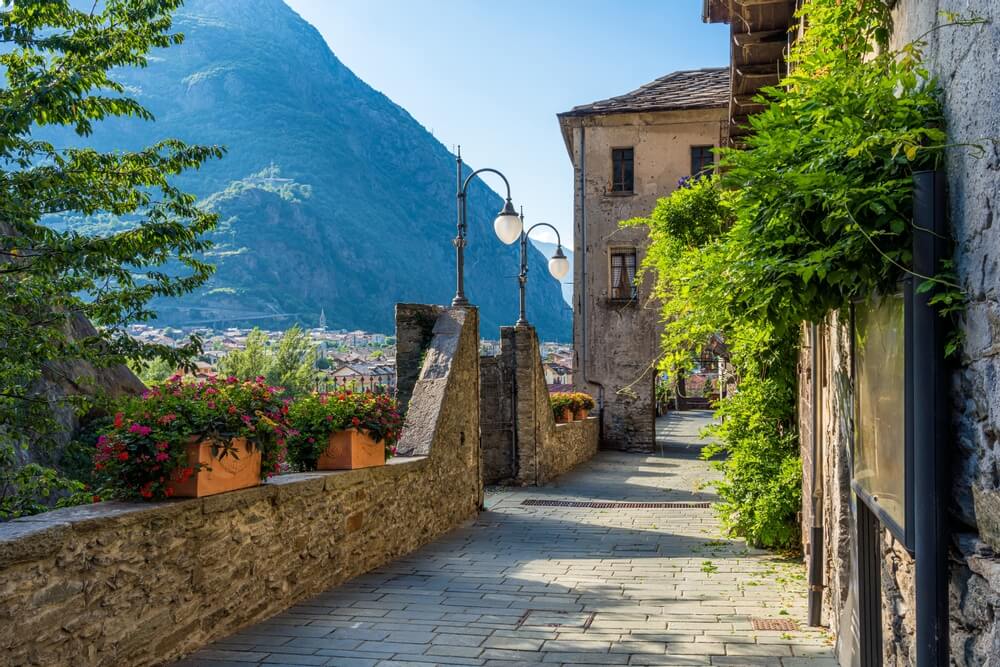
Moreover, he designed an eye-catching open terrace on the second floor of the Fort. The open balcony features a royal throne under a wooden canopy constructed with skilled craftsmanship in an impressive mogul style. The open terrace offers a breathtaking view of the Hunza valley through its balcony.
Beautiful view of mountains from Baltit Fort
One of the major attractions of Baltit Fort Gilgit Baltistan is that you have a breathtaking view of Karakorum highway with its snaking motion along the enchanting Hunza valley from the altitude of Baltit Fort. Moreover, from the rooftop of Baltit Fort, you will have the privilege to experience the most spectacular view of the highest mountain ranges of Gilgit Baltistan, including the snowcapped Rakaposhi, Ultra mountain, ladyfinger peak, Diran Mountain, and golden peak.
You will feel yourself small standing amongst these majestic creations of nature. The Fort is standing between the Hunza and Nager valley. It will not be wrong if I say that it is a heaven for nature-loving people as beauty lies in the eyes of the beholder. If you love mother nature, a journey to this mesmerizing location never feels dull.
Guest room at Baltit Fort
Upon reaching the second floor of the Fort through a staircase, you will come across diwan-e-Khas, also called guest rooms. The room’s design allowed it to remain warm and comfortable throughout the winter, so the rulers used it then. The rulers used the guest room to meet prominent personalities and hold important meetings. The room has many artifacts preserved and displayed beautifully.
Stone age cooking wares
Enchanting artifacts in the guest room include an old wooden chair and a telephone of ancient times. Some stone-age cooking wares and imported jugs and glasses. Some 300 years old, carpets cover the entire floor of the guest room. A luxurious rug is adorning the wall, which the ruler of Hunza used when influential personalities came to meet him.
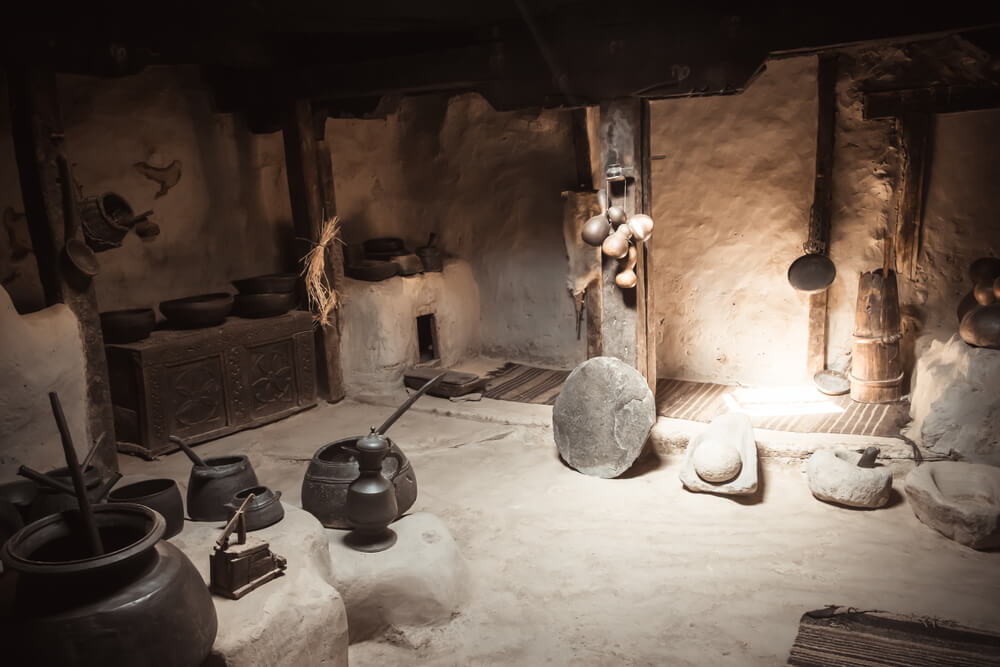
Tibetan musical instruments
Baltit Fort’s drawing room features a collection of Tibetan string musical instruments used in religious gatherings to recite spiritual poems from Persian literature. There are colorful royal sofas, where royals used to sit and enjoy social groups.
Old carved wooden cabinets and decorative plates
The sitting area of the Fort comprises old carved wooden cabinets where royals kept their essential items of daily use. Decorative plates and teapots are also there in a well-preserved condition.
The guard room
The guard room is present on the first floor of the Fort. Architects designed it according to the old architectural style of the Baltistan region. It is a small room with a small wooden door made up of stones, providing beautiful views of the valley.
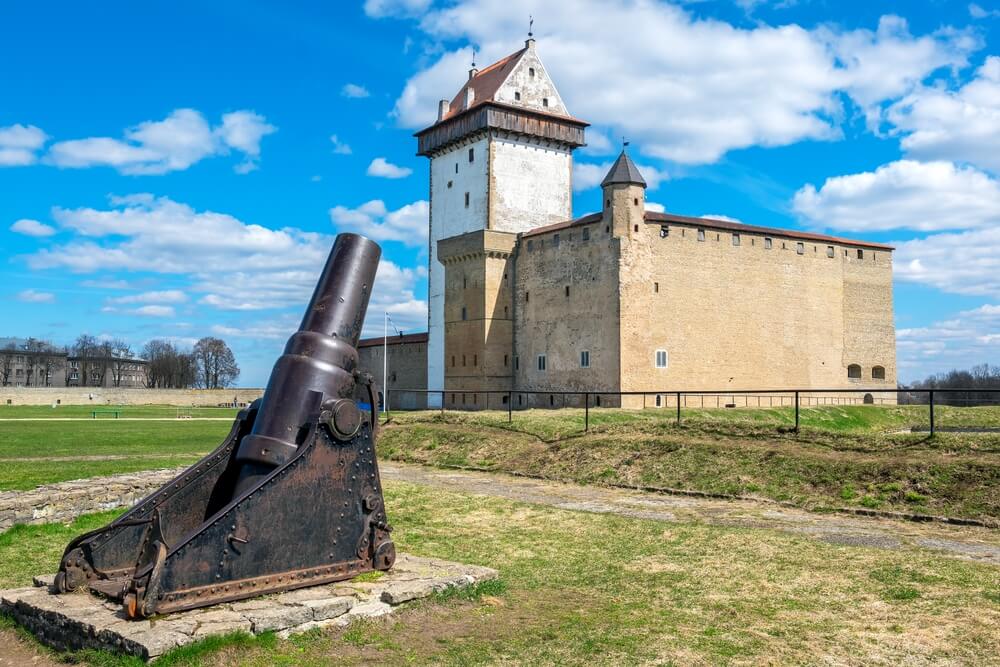
Kitchen
The first floor of the Fort also features a royal kitchen occupied by many cooking utensils of old times, including teapots, mortar and pestle, and large cooking pots used by the royal family.
Antique local artifacts
Wooden paneling, elaborate labyrinths of carved wooden pillars, antique local artifacts like local rugs, old firearms, calligraphy on the walls, and wooden cribbage work adorned the Fort. In addition, ceremonial robes used by the rulers of the Hunza are beautifully displayed on glass shelves to preserve the cultural heritage of the Hunza people.
Old Chinese paper currency
Old Chinese currency notes from 1920-1923 are also well-organized on the glass shelf. This gesture depicts the cordial relationship between china and Hunza.
Shahi Hammam
A small shahi hammam or royal bath house is also present in the Fort used by royals. The entrance to the bathroom is through a small door.
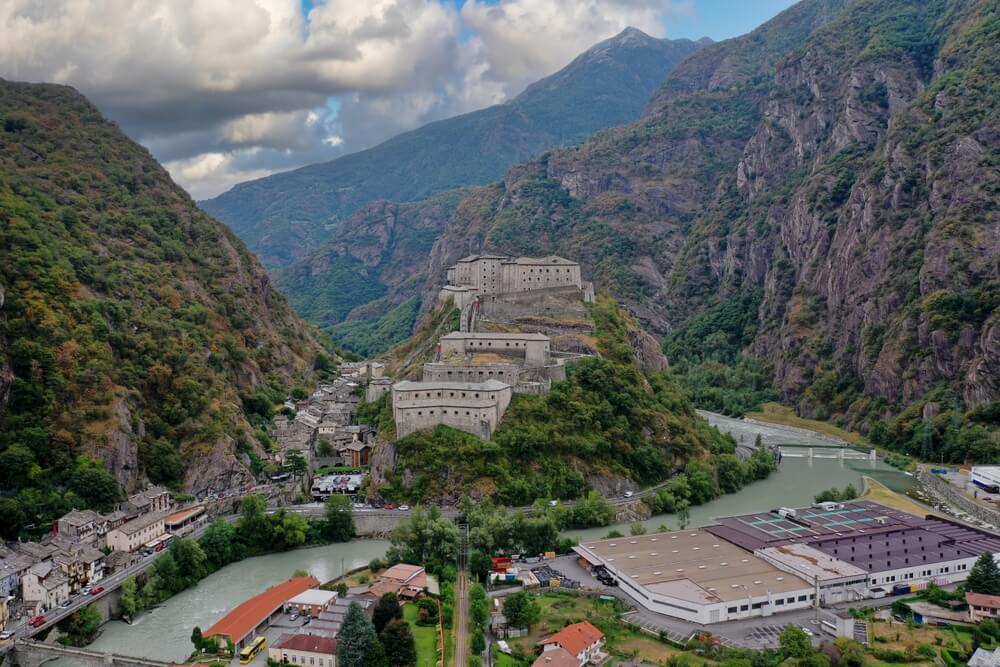
Old Cannon
The relations between Hunza valley and Nager valley had remained inadequate and fragile since the 9th century. Upon recognizing the dangerous political condition of Hunza, Mir of Hunza, in 1863, decided to design a canon in the Hunza for protection. Adina Baig, a cannon designer of that time, manufactured the cannon on the orders of Mir Ghazzan in a short time. They test-fired it in 1863, which proved successful. This old canon is on display in the Baltit Fort, featuring the historical past of Hunza.
Old Galleries
There are many old galleries located inside the Baltit Fort. Old photographs of all the rulers of the Hunza are hanging on the wall of one of the galleries. In the same gallery, the ceremonial dress of the king and queen of Hunza is also present.
Nearby Restaurant
A Baltit tea cafe or a small restaurant locates on the premises of Baltit Fort, from where you can order tea, coffee, sandwiches, and other food items. The cafe features a small comfortable sitting area where you can eat, relax and enjoy breathtaking views of the surrounding Hunza valley and mighty mountains.
Baltit Fort hunza ticket price
The ticket price for Baltit Fort Karimabad is PKR 800 for locals and PKR 1000 for foreigners. The fee for your tour guide is also at this price. Upon entering Baltit Fort, you will see a small ticket house where you can pay for the ticket.
Baltit Fort timings
The visiting hours of the Baltit Fort, Kariambad, and Hunza are 9:00 AM to 5:00 PM. Baltit Fort is open for visitors on all seven days of the week. The best time to visit the Baltit Fort in Hunza is between April to October. The weather during this time is divine. You can see the Fort from November to January to enjoy snowfall.
Location of Hunza Baltit Fort
This iconic Baltit Fort locates near the famous and picturesque town of Hunza, Karimabad, in the Gilgit Baltistan region of Pakistan. Karimabad is renowned for cobblestone streets, cafes, and traditional bazaars from where you can buy cultural Hunza-ware on your way to Baltit Fort. As you travel on the roads of Karimabad, you can enjoy a splendid view of the mountains on your right side.
FAQs
Why is Baltit Fort famous?
Baltit Fort, located in the heart of Gilgit Baltistan, is a famous tourist attraction visited by millions of people from all over the globe. This fortress is famous for its Tibetan architecture and breathtaking view of the beautiful Hunza valley between the world’s highest mountain peaks. If you are traveling to Gilgit Baltistan, then make sure to visit this Fort. You will not regret it.
Who made the Baltit Fort?
The Tibetan architects built the Baltit Fort 750 years ago on the instructions of the ruler of Baltistan, King Raja Abdal. Architects used stones throughout the Baltit Fort’s construction, and the walls were strengthened with traditional craftsmanship using precious wood. Architects constructed Fort’s walls with solid brickwork and stonework using soil mortar.
Why is Baltit Fort different from other forts?
Baltit Fort, standing amongst the world’s highest mountains, is a heaven on earth for people admiring nature’s beauty and searching for magnificent historical sites. That’s why Guardian enlist Baltit Fort in the top five “Best Tourist sites” in Pakistan.
Conclusion
The astonishing views of Baltit Fort Karimabad, Pakistan, will take your breath away. In the 1960s, people would either drive there or embark on a demanding hike from the Gilgit villages in the lower valley, which could take up to four days. When the Karakoram highway was constructed, which linked Islamabad to western china, Karimabad is now accessible to its visitors by road. This place is for you if you are looking for a fantastic tourist spot. Thanks, me later!
